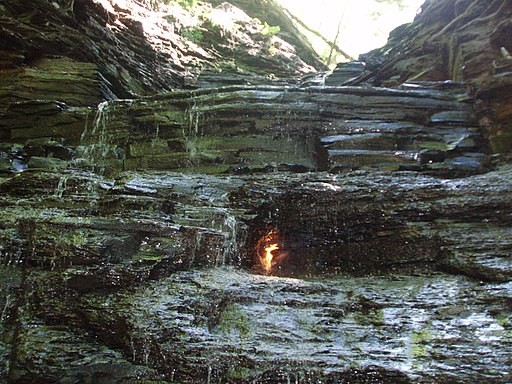All around the world, there are man-made eternal flames that are maintained for various reasons, such as tribute to heroes or commemoration of war victims. Peat fires, natural gas leaks, and coal seam fires also cause natural eternal flames. Deep within a park in New York lies a natural reserve with a small waterfall that hides an unusual eternal flame.

New York's Eternal Flame Falls
The mysterious phenomenon can be observed in a 35-foot11-meter) waterfall in Shale Creek Preserve at Chestnut Ridge Park. Hidden beneath this waterfall is fire as high as 4 to 8 inches (10 to 20 centimeters,s), which never burns out.
Also known as Eternal Flame Falls, this body of water depends heavily on rainfall and meltwater. It usually flows exclusively in early spring or after long bouts of heavy rain. It also reaches 30 feet (9 meters) high, cascading over sloping shale in two segments.
It is believed that the flame was first lit by Native Americans several hundreds or thousands of years ago. Despite its name, the flame is not eternal since it goes out occasionally. It is often re-lit by the next hiker, who may find it extinguished.
READ ALSO: When Did Humans Discover Fire? How Did the Blazing Flames Shape Our History?
What Keeps the Eternal Flame Burning?
For a long time, experts have believed that the fire at Eternal Flame Falls burns due to gas pockets that rise from the old, extremely hot bedrock composed of shale. The high temperatures of the rock break down the carbon molecules in the shale, which creates natural gas.
As a hiker approaches the falls, the smell of rotten eggs hits their nose. This odor is believed to be the smell of natural gas that leaks between the shale layers. As the organic matter within the rock deposits decomposes, it releases gas, which is pushed out through cracks and loose layers within the rock.
One of the large fissures is found right within Eternal Flame Falls. A small cave or grotto, 5 feet (1.5 meters) up from the creek bed, protects the gas seepage from the falling water and wind, enabling a sustained flame when lit. Two smaller seepages within the hatch can also be burned, but they cannot hold a flame as large or as long as the primary flame.
Several other gas seepages, or springs, can be found around the falls, although locating them can be tricky, and lighting them is often impossible. Somm are located underneath the pool below the fire and can only be seen as bubbles that rise from the bedrock below.
However, Arndt Schimmelmann and scientists from Indiana University found out that the rocks beneath the Eternal Flame Falls are not hot enough to produce this reaction. According to Schimmelmann, the rocks were only as hot as a cup of tea, and the shale was not as old as first expected.
The team hypothesized that something else keeps the eternal flame burning, although they are still unsure what that may be. They proposed that there could be a different pathway of gas generation in this location. If true, the state has much more shale-gas resources than previously thought.
RELATED ARTICLE: Ancient Humans Learned to Use Fire 1 Million Years Ago As Detected in Animal Fossils, Tools That Heated Over 400 Degrees Celsius
Check out more news and information on Fire in Science Times.














